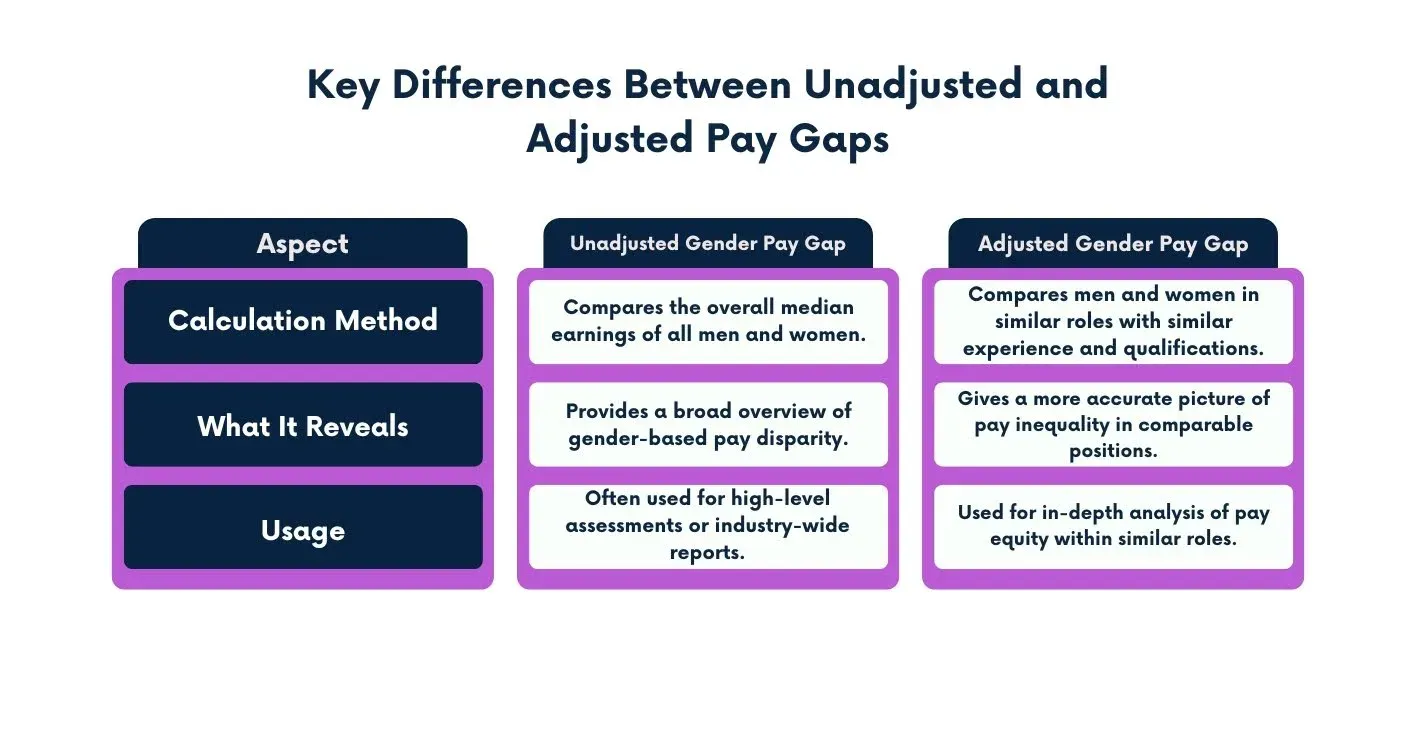
Gender pay disparity remains a significant issue in workplaces across the globe, despite years of effort towards equality. In fact, studies show that women in the U.S. still earn about 82 cents for every dollar earned by men, a figure that highlights the persistent wage gap.
But here's the catch: this statistic doesn't tell the full story.
When it comes to understanding the gender pay gap, one size doesn’t fit all. Without recognizing the distinction between the unadjusted and adjusted gender pay gaps, businesses might misinterpret the scale of inequality, leading to misguided actions.
By delving into the two types of gender pay gaps, organizations can better identify areas that require attention and develop more effective strategies for pay equity. In this post, we will explore the differences between the unadjusted and adjusted gender pay gaps. Understanding these differences is important for identifying the root causes of pay disparities.
We will also discuss why having a clear grasp of both gaps is essential for creating a fair and transparent compensation structure within your organization.
The gender pay gap refers to the difference in earnings between men and women, and it’s often used as a measure of gender equality in the workplace. Although the gap may seem like just a straightforward salary comparison, it’s actually a more intricate issue influenced by multiple factors. This includes factors like industry, job roles, experience, and working hours.
For many businesses, the gender pay gap serves as a critical indicator of how well they are doing in promoting equality and fair compensation. Addressing this gap isn’t just a matter of ethics—it's also increasingly important for maintaining a competitive and inclusive work environment.
In fact, according to the World Economic Forum, at the current rate of change, it will take over 134 years to close the gender pay gap globally. This sobering statistic highlights the urgency for companies to take meaningful action.
However, understanding the gender pay gap requires more than just looking at the overall figures. It is important to understand the differences between the two types of gender pay gaps to truly address the problem.
Suggested Read: Understanding Pay Transparency Laws in Different States - 2025 Guide
The unadjusted gender pay gap refers to the overall difference in average earnings between men and women in a specific organization or industry. It is calculated by comparing the median hourly wages or annual salaries of all male and female employees, without adjusting for factors like job type, experience, or working hours.
According to the Census Bureau data from 2018, the unadjusted gender pay gap is 18 cents. This means that, on average, women earned 18% less than men across all occupations.
While this provides a broad view of wage disparity, it doesn't account for key variables that influence earnings, leading to potential misinterpretation of the gap’s true extent.
Why can the unadjusted gender pay gap be misleading?
While the unadjusted gender pay gap offers a broad overview, it doesn't provide the full picture. To gain a clearer understanding of pay inequality, we need to look at the adjusted gender pay gap, which accounts for variables like job role, experience, and working hours.
This adjusted figure allows for a more accurate comparison between men and women who are in similar positions. This can lend your organization better insight into how gender might still influence pay within comparable roles.
Suggested Read: Understanding the Difference Between Pay Equity and Salary Equality
The adjusted gender pay gap takes a more refined approach. It compares the earnings of men and women who occupy similar roles, with similar levels of experience, education, and working hours. Unlike the unadjusted gap, this measure accounts for key factors that can influence pay.
To calculate the adjusted pay gap, the wages of men and women are compared after controlling for differences in job responsibilities, experience, qualifications, and work patterns. This provides a clearer picture of how much of the pay gap is due to gender alone, rather than other external factors.
Why the adjusted pay gap is more insightful:
You can better understand whether pay disparities exist due to gender or if other factors like job type or experience level drive them. This clearer picture allows for more targeted interventions and policies aimed at closing the gap.
Understanding the distinctions between the unadjusted and adjusted gender pay gaps is vital for accurately assessing pay equity within an organization. These two metrics provide different insights. Recognizing their key differences helps businesses better target their efforts to close the gender pay gap.
Suggested Read: How to Implement an Equitable Compensation System

While both the unadjusted and adjusted gender pay gaps are critical in understanding wage inequality, they reveal different aspects of the issue.
The unadjusted gap offers a broad overview, reflecting the overall disparity between men and women across various roles. It provides a snapshot of how pay compares on a general scale.
On the other hand, the adjusted gap takes a more detailed approach, focusing specifically on pay differences within similar job roles, accounting for factors like experience and qualifications.
These are the key distinctions between these two metrics and how each one plays a unique role in evaluating pay fairness. Here’s a more detailed breakdown of the key differences:
Now that we have explored the key differences between the unadjusted and adjusted gender pay gaps, it’s time to turn our focus to actionable steps.
Closing the gender pay gap requires more than just understanding the data—it demands intentional strategies. Let’s look at some practical approaches that can help organizations address and reduce these disparities effectively.
Suggested Read: What is Merit Pay And How Does It Impact Salary Increases?
Addressing the gender pay gap requires a proactive and structured approach. While understanding the differences between the unadjusted and adjusted gender pay gaps is important, taking action is essential to close these gaps.
Here are some effective strategies that organizations can implement to promote pay equity and ensure a fairer compensation structure:
Implementing these strategies can significantly reduce the gender pay gap. It can contribute to a more equitable workplace where all employees are fairly compensated for their work. By taking action and prioritizing fairness, organizations can create an inclusive culture that values diversity and equality.
Suggested Read: How to Determine and Build a Compensation Range?
Technology can play a vital role in achieving pay equity. One such solution is CompUp. This is a platform that harnesses the power of AI to drive fair compensation practices. The next section explains how CompUp is transforming the way businesses approach compensation fairness.
CompUp leverages advanced AI-powered solutions to help organizations identify, address, and prevent pay biases while promoting fair and equitable compensation.
Through its cutting-edge technology, CompUp provides businesses with actionable insights into their pay practices. The platform can enable you to make data-driven decisions that foster an inclusive and fair work environment.
Here’s how CompUp’s AI-driven platform supports organizations in achieving pay equity:
CompUp's AI tools analyze vast amounts of compensation data to identify patterns of pay bias across different departments, roles, and even regions. By recognizing discrepancies that may not be obvious, the platform helps businesses pinpoint areas where gender, race, or other factors might be influencing pay unfairly.
AI algorithms within CompUp suggest fair pay adjustments based on market trends, industry benchmarks, and internal compensation structures. This ensures that pay increases and adjustments are consistent, equitable, and aligned with performance, while minimizing the potential for human bias to influence compensation decisions.
CompUp uses AI to match employees with similar roles, experience levels, and qualifications to ensure that individuals in comparable positions are compensated fairly. By analyzing skills, experience, and job responsibilities, the platform provides businesses with a more accurate view of compensation practices, making it easier to implement fair pay policies.
CompUp’s predictive analytics capabilities allow organizations to forecast compensation trends and identify potential pay gaps before they become issues. By using historical data and market trends, businesses can proactively address pay disparities and make informed decisions about future compensation plans.
With these AI-powered tools, CompUp empowers businesses to take the guesswork out of compensation decisions. It ensures that pay is equitable and transparent across all levels. By analyzing vast datasets, the platform identifies subtle patterns in compensation.
It allows businesses to address disparities influenced by gender, race, or other biases before they become entrenched.
Addressing the gender pay gap is essential for creating a fair and productive work environment. Organizations can better assess where disparities exist and take the right steps toward closing those gaps by understanding both the unadjusted and adjusted gender pay gaps. It’s clear that real change comes from actionable insights and consistent efforts to ensure fair compensation.
While traditional methods offer some perspective, technology is now playing a key role in driving meaningful change. AI-powered platforms like CompUp are making it easier for businesses to detect pay biases, suggest fair pay increments, ensure accurate job matching, and predict future compensation trends.
If you are ready to take your organization’s compensation strategy to the next level and ensure gender pay equity, CompUp provides the perfect solution. Book a demo now.
Why is it important to understand both the unadjusted and adjusted gender pay gaps?
Understanding both gaps allows organizations to get a fuller picture of the pay disparities that may exist. The unadjusted gap offers a high-level overview of gender wage inequality, while the adjusted gap helps identify specific instances where pay discrepancies exist within similar roles.
What role does AI play in addressing the gender pay gap?
AI can help organizations identify hidden pay biases by analyzing large datasets and detecting patterns that might not be obvious through traditional methods. AI also suggests fair pay increments, matches jobs more accurately, and forecasts future pay disparities.
How does CompUp help businesses with pay equity?
CompUp uses AI-driven tools to detect pay biases, suggest fair pay increments, match employees to similar roles with accurate compensation, and predict future pay trends. This helps businesses ensure that pay is equitable across all departments and roles.
Can CompUp integrate with existing HR or payroll systems?
Yes, CompUp is designed to seamlessly integrate with various HR, payroll, and compensation management systems. This ensures that businesses can leverage AI-driven insights without disrupting existing workflows, making it easy to adopt pay equity best practices across the organization.
How can I get started with CompUp?
To get started with CompUp, simply book a demo through our website. A demo will give you a chance to explore how their AI-powered platform can help you address pay inequity and optimize compensation strategies within your organization.

Community Manager (Marketing)
As a Community Manager, I’m passionate about fostering collaboration and knowledge sharing among professionals in compensation management and total rewards. I develop engaging content that simplifies complex topics, empowering others to excel and aim to drive collective growth through insight and connection.
Revolutionizing Pay Strategies: Don't Miss Our Latest Blogs on Compensation Benchmarking